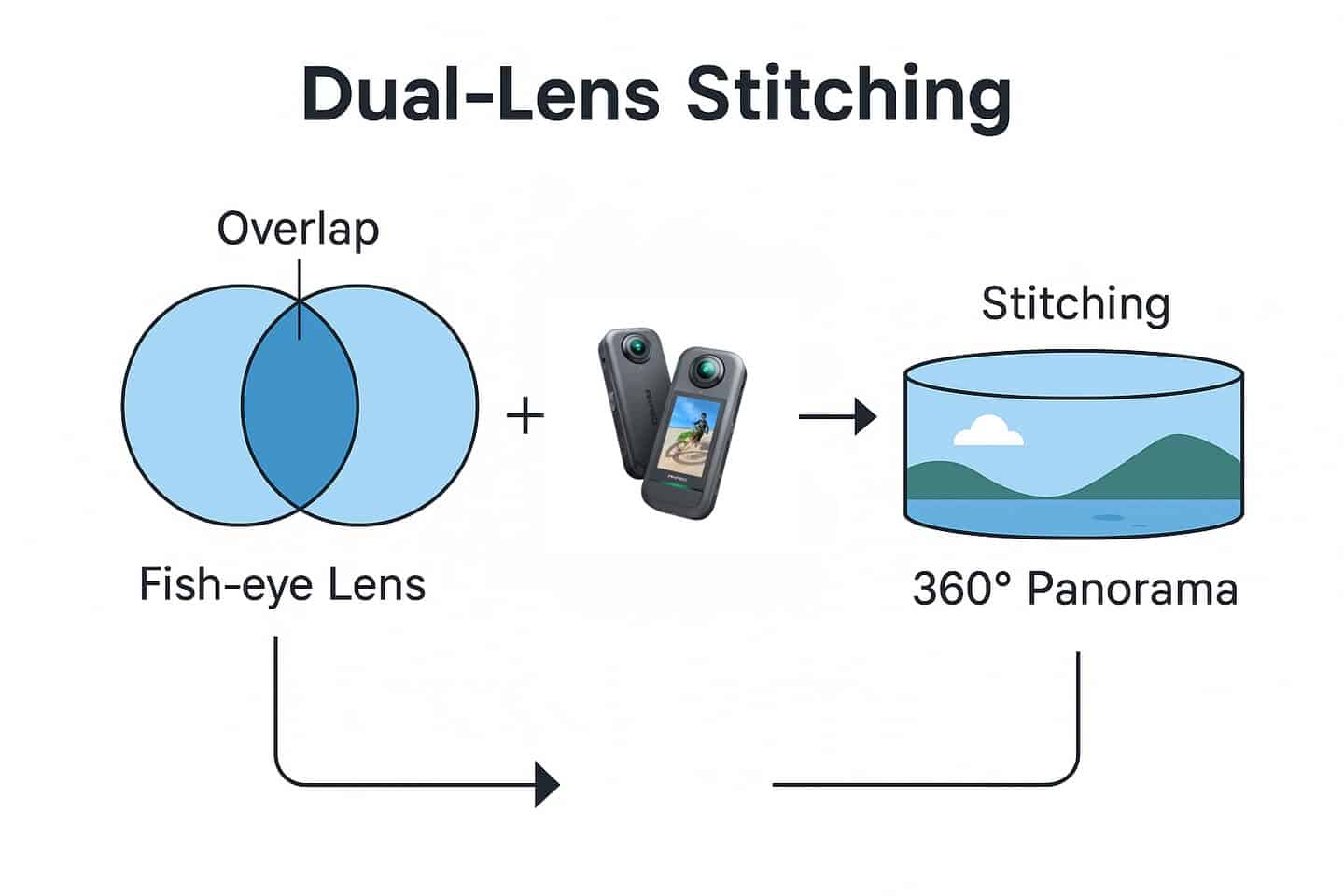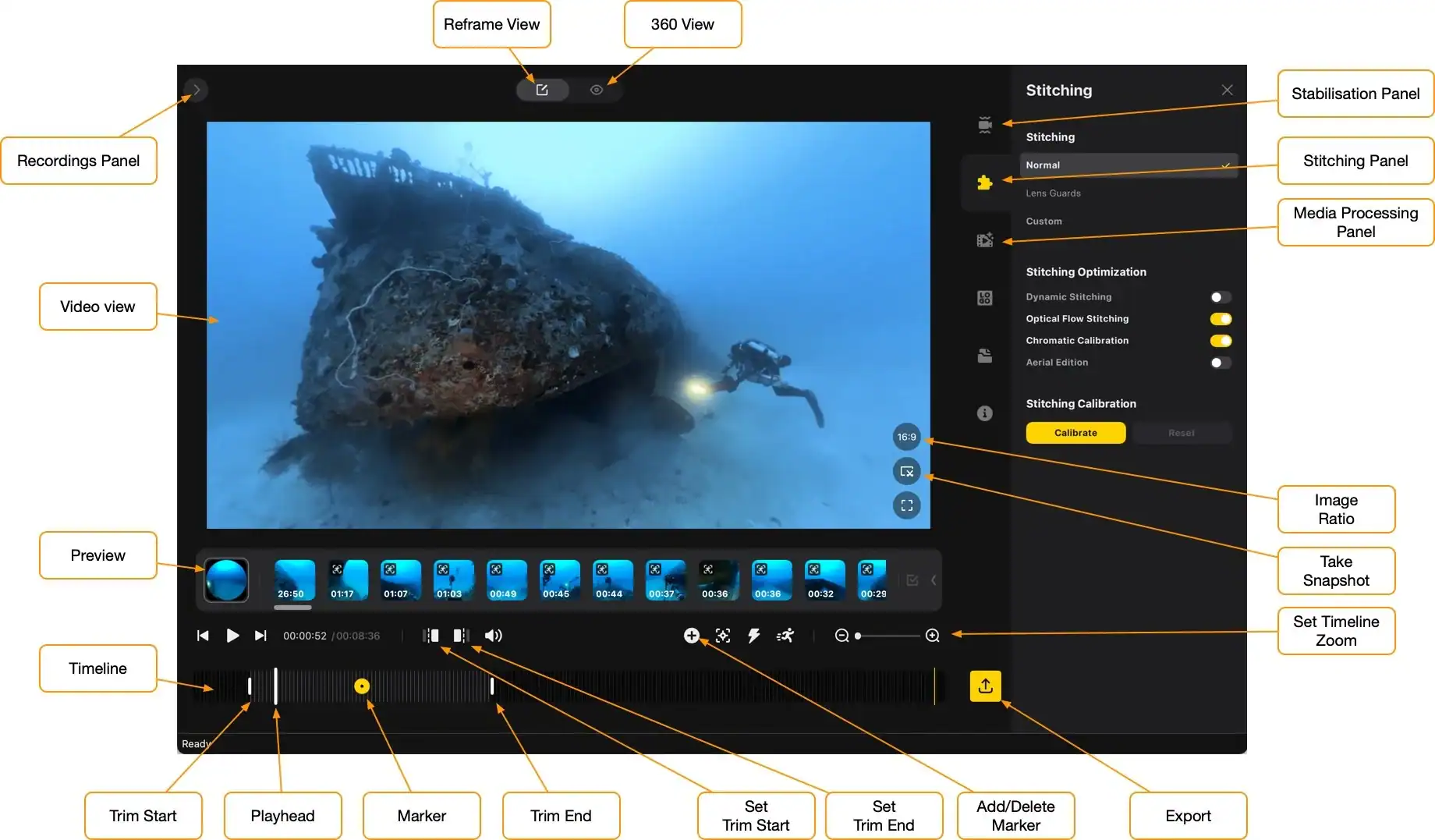What Is 360 Camera Editing Software?
360 camera editing software allows creators to transform raw dual-fisheye images from cameras like Insta360, Ricoh, or GoPro into smooth, immersive footage. These programs handle stitching, stabilization, color correction, and reframing — essential steps before publishing a virtual walkthrough or 360 video tour.
Modern editors support equirectangular projection, the native 2:1 format for spherical video. They let you adjust exposure, patch tripod areas, and add titles that follow the viewer’s perspective. Whether you’re a real-estate agent or VR filmmaker, proper 360 editing ensures viewers experience seamless transitions and realistic motion.
- Stitching workflow: Dual fisheye → stitched equirectangular panorama → reframed export.
- VR formats: Monoscopic (flat depth, lightweight) vs. Stereoscopic (full 3D depth).
- Platform support: Facebook, Vimeo, and YouTube now natively play 360° video, encouraging more creators to enter this field.

Pro tip: For VR-ready quality, export at 5.7K or higher. The free version of DaVinci Resolve caps reframed output at 4K, while the Studio version supports up to 8K workflows.
Why Edit Before Building a Virtual Walkthrough?
High-quality editing is crucial for viewer comfort and engagement. In real estate, for instance, a 360 camera is typically placed on a tripod at the center of each room. Editors trim the clip to allow roughly 30 seconds per room, creating a natural rhythm for buyers exploring properties remotely. Clearer visuals and smooth motion directly translate into higher viewing time and better lead conversion.
After editing, you can upload polished media into Panoee’s free virtual walkthrough builder, add hotspots or labels, and publish instantly. Clean media also reduces load time, making the final virtual tour more responsive on mobile devices and VR headsets.
Best 360 Camera Editing Software in 2025
The 360 editing market has grown rapidly as consumer and professional creators adopt immersive storytelling. Below are the leading tools and their special strengths:
| Software | Highlights | Limitations |
|---|---|---|
| Insta360 Studio | Designed for fast trimming and reframing. Uses lower-resolution proxy files for speed and includes AI features like Deep Track 2.0 and Shot Lab (30+ templates). Ideal for creators who want quick results without complex timelines. | Limited advanced color or audio tools; best for quick social or walkthrough clips. |
| Pinnacle Studio | Leader in consumer 360 editing with over 2,000 built-in effects and direct fisheye support. Excellent for beginners learning how to stitch and reframe footage. | Windows-only; lacks multi-user project sharing for teams. |
| Final Cut Pro | Optimized for Mac; benchmark tests show faster render speeds than Premiere or Resolve. Handles stabilization, keyframing, and seamless export to YouTube 360. | macOS exclusive and requires paid license. |
| Adobe Premiere Pro | Full professional suite with VR plugins, dynamic reframing, and color grading tools. Integrates well with After Effects for motion graphics. | High system requirements; subscription pricing. |
| DaVinci Resolve Studio | Renowned for precise color grading and Fusion 3D compositing. The Studio version supports 5.7K+ exports essential for professional VR delivery. | Learning curve can be steep for new users. |
Many editors also rely on cross-platform tools such as VEGAS or MAGIX for flexible reframing and stabilization workflows. The right choice depends on your camera model, operating system, and whether you’re producing cinematic VR or practical tours for business use.

How to Edit 360° Footage: Step-by-Step Workflow
- Import and stitch your raw dual-fisheye files into an equirectangular video.
- Stabilize the horizon using gyro or motion data if your camera provides it.
- Trim and arrange clips; keep each scene concise (20–30 seconds) for easy navigation.
- Correct color and exposure to ensure uniform lighting across all rooms or environments.
- Add titles or transitions if reframing for social media outputs — 16:9 for YouTube, 9:16 for TikTok or Reels, 1:1 for square posts.
- Export at 5.7K+ for professional VR headsets or at 4K for web distribution.
- Upload to Panoee and build your virtual walkthrough using its drag-and-drop editor.
Expert Tips & Common Mistakes
- Always back up raw footage. Stitching and stabilization can be destructive if you overwrite files.
- Watch your metadata. Incorrect 360 metadata can prevent playback on major platforms.
- Use proxies for smooth playback. Lower-res proxies accelerate editing and reduce crashes.
- Check seams early. Fix stitching errors before color grading; they become harder to correct later.
- Optimize export settings. For VR headsets, choose H.265/HEVC to maintain detail at smaller file sizes.
FAQ: 360 Editing Essentials
- What file format should I use when exporting 360 videos?
Export in MP4 (H.265) for general sharing or MOV (ProRes) for professional post-production. Ensure metadata flags mark it as 360 so platforms auto-detect panoramic mode. - Can I edit 360 videos on a regular laptop?
Yes, but performance depends on GPU and CPU. Using proxy files or low-resolution previews can speed up editing without affecting final output quality. - Which software is best for quick social media edits?
Insta360 Studio offers AI tracking and one-tap templates for Reels or TikTok. It’s perfect for trimming and reframing 9:16 vertical videos in minutes. - Do I need expensive gear for professional results?
Not necessarily. Many affordable 360 cameras shoot 5.7K footage. The key is stable tripod placement and thoughtful lighting rather than high-end hardware. - How do I fix visible stitching lines?
Use your editing app’s seam correction or mask tools, or manually adjust alignment in the stitching panel before export. - What’s the difference between monoscopic and stereoscopic 360?
Monoscopic captures one image sphere (flat depth), while stereoscopic uses two images for each eye, producing realistic 3D depth perception in VR headsets. - Which resolution is recommended for VR headsets?
Professional VR playback typically requires at least 5.7K. For cinematic experiences, 6K–8K ensures sharper visuals when magnified through lenses. - Can I turn my 360 edits into an interactive tour?
Yes. Once your media is edited, upload it to Panoee to add hotspots, transitions, and publish your interactive walkthrough free of charge.
From Editing to Publishing — Go Immersive
Editing 360 footage isn’t just technical polishing — it’s how you guide your viewer’s attention. With professional tools and careful exports, your scenes look natural, sharp, and ready for the next step. Try Panoee today to transform your edited footage into a live, interactive experience viewable on any device.